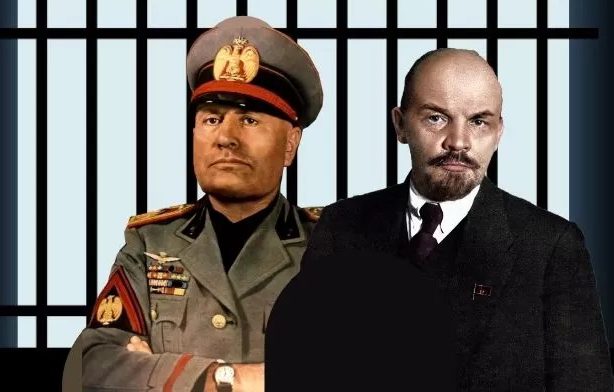Surprise: Mussolini Was Not the First Fascist
Charges of fascism are often flung around like paper confetti, sometimes to cover for actual fascism. Almost every political faction has been subjected to such claims, especially ones that are polar opposites of historical Italian fascism and German National Socialism. Even Canadian truckers seeking an end to covid lockdowns have been savagely attacked as Nazis, along with freedom-based organizations that supplied the intellectual ammunition to oppose Hitler’s and Mussolini’s ideologues.

So the question becomes this: What is fascism, and where did it originate? Consensus often points to post–World War I Italy. However, that old belief is starting to crumble. Fascism and its state-oriented mixed economy appear to have an earlier starting date. Some scholars are now pointing at Soviet Russia.
Benito Mussolini may be the world’s most notorious fascist, but he was not the first to introduce socioeconomic and political fascism to the world. In actuality, this Italian Marxist intellectual simply popularized the word. The socioeconomic mechanics behind Fascism came from another Marxist, one deep inside Russia. He was a Russian revolutionary whom Mussolini lionized: Vladimir Lenin.
After Lenin secured control of Russia in 1921, his unrelenting nationalization of the Soviet economy finally collapsed. Moscow and other Russian cities transformed into walking-dead hellscapes. Most factories and mills closed. Most Russians were starving. Workers fled to the countryside to find food. Hundreds of violent riots spread across the land. Lenin and the communists were almost overthrown. Karl Marx’s dreams of a socialist worker’s paradise had failed.
Under these dire conditions, Lenin had to change direction. He reluctantly rolled back the communist economic system and established a mixed economy: the state still owned the big industries but allowed small companies, farmers, and individuals to exist and engage in open commerce. At this point, Lenin embraced Marxist-lite Fascism by supporting an alternative “third way” between socialism and capitalism, a concept Lenin and Mussolini called “state capitalism.” The political sociologist Seymour Martin Lipset concurred, arguing that Fascism is “extremism of the center,” referring to its reliance on a mixed economy. He contended that Fascism is not right-wing because Mussolini did not plan to restore monarchical or aristocratic privilege.
In 1921, Lenin dubbed his revised economic policies the New Economic Policy (NEP), which introduced a form of “market socialism,” “crony capitalism,” or what he approvingly termed “state capitalism.” Lenin described this change as the “development of capitalism under the control and regulation of the proletarian state.” This meant that fascism was not the “last stage of capitalism” as Marxist historians have maintained, but the first stage of a pullback from the economic and political failures of Marxism-Leninism. Lenin’s policies to mitigate the defects of absolute nationalization and communism spawned the NEP and produced a fascist economy.
Under his NEP policies, Lenin said he would allow “a free market and capitalism, both subject to state control,” while socialized state enterprises would operate on “a profit basis.” His policy even allowed the ownership of small companies, which were privatized from former state-owned enterprises. And by initiating a mixed economy in 1921 and early 1922, Lenin became the world’s first fascist dictator, over a year before Mussolini was appointed Italy’s prime minister in late 1922.
Who makes such a bold claim? It was Peter Drucker, the famous professor of politics, philosophy, and management, who lived in Germany in the early 1930s. He asserted that fascism came out of communism in his 1939 The End of Economic Man. He wrote, “Fascism is the stage reached after communism has proved an illusion. … Communism in anything but name was abandoned in Russia when the Five-Year Plan was substituted for the New Economic Policy (NEP).”
Since Mussolini, Lenin, and Trotsky were Marxist chums in Switzerland, it is not surprising that Mussolini closely watched Lenin and his regime with keen interest. Considering himself a disciple of Lenin, Mussolini proposed that Italy should officially recognize the Soviet Union in 1923. According to Stanley G. Payne in his History of Fascism, 1914–1945, “Not only was Italy the first Western country to recognize the Soviet Union in 1924, but the new Soviet art first appeared in the West that year at the Venice Biennale, Italy’s premiere art show.” In the Italian elections of 1919, as the leader of the Fascist Revolutionary Party, Mussolini publicly compared himself to Lenin, bragging that he was the “Lenin of Italy.”
When Lenin ushered in the NEP, Mussolini felt compelled to imitate Lenin’s market-oriented economic policies. The prime minister of Italy, Francesco Saverio Nitti (1919–1920), noted this coziness, writing, “In Italy today one finds that greater tolerance is shown toward Communists affiliated with Moscow than to Liberals, democrats, and Socialists.” He also remarked, “Fascism and Bolshevism are the same.”
Mussolini understood what Lenin was trying to do in Soviet Russia. Considered one of the greatest Marxist theoreticians of the 20th century, Mussolini realized that Lenin was following Karl Marx’s precepts to the letter. Marx argued that only ruthless industrial capitalists could successfully bring the population out of feudalism and poverty. Since Russia’s economy was primarily agricultural, some limited form of capitalism was required to get it to the Marxian sweet spot of a highly industrial state. Lenin argued for the “full maturation of capitalism as the precondition for socialist realization.”
Fascism sprang out of Marxism over the Marxian reaction to the failures of Lenin’s Bolshevism in the Soviet Union. In other words, many strands of revised Marxism devolved into Italian Fascism. A. James Gregor, a political scientist at U.C. Berkeley, agreed, writing, “The first Fascists were almost all Marxists — serious theorists who had long been identified with Italy’s intelligentsia of the Left.” The former English socialist David Ramsay Steele succinctly declared, “Fascism began as a revision of Marxism by Marxists.”
Indeed, Lenin and the Bolsheviks ushered in the first fascist socioeconomic system, scattering across Europe. Winston Churchill also noted this political evolution, writing in 1948: “As Fascism sprang from Communism, so Nazism developed from Fascism.”
yogaesoteric
June 16, 2022
